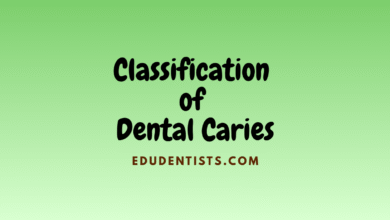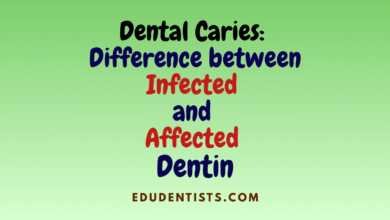Conservative Dentistry Lectures
Root Caries: Overview and Management
Root Caries: Overview and Management

Root Caries: Overview and Management
Definition:
Root caries is a soft, progressive lesion found on root surfaces exposed due to gingival recession or periodontal attachment loss. It typically occurs at or below the cementoenamel junction (CEJ) and appears discolored compared to healthy root surfaces.
🔹Key Features of Root Caries
- Initiated when periodontal attachment is lost → root exposed.
- Lesions are soft, irregular, and progressive.
- Shape: round or oval, may spread radially and merge with other lesions.
- Color: white, light brown, or dark, sometimes with cavitation.
- More common in males.
- Teeth most affected:
- Mandibular: molars → premolars → canines → incisors
- Maxillary: reversed order
🔹Etiology of Root Caries
Microbial Factors:
- Key bacteria: Streptococcus mutans, Lactobacillus, Actinobacillus
- Mechanism: sugars → organic acids → demineralization
- Root demineralization occurs at pH 6.4 (higher than enamel pH 5.5)
- Root demineralizes faster due to lower mineral content (55%) vs enamel (99%)
Intraoral Risk Factors:
- Xerostomia, low salivary buffer
- Poor oral hygiene
- Gingival recession, periodontal disease, or surgery
- Frequent carbohydrate intake
- Malocclusion, tipped teeth
- Abfraction lesions
- Unrestored or restored teeth
- Overdentures and removable partial dentures
Extraoral Risk Factors:
- Advanced age
- Medications reducing saliva (antipsychotics, antihistamines, sedatives)
- Low socioeconomic/educational levels
- Diabetes, Sjögren’s syndrome, autoimmune disorders
- Radiation therapy
- Limited manual dexterity
- Limited exposure to fluoridated water
- Alcohol or narcotics consumption
🔹Diagnosis of Root Caries
- Clinical Examination: Clean surface, use explorer for soft/leathery areas.
- Radiographs: Accurate, free from overlap or burnout.
- Special Dyes: Highlight infected dentin for detection.
Differential Diagnosis:
| Feature | Active Root Caries | Arrested Root Caries | Extrinsic Stain |
|---|---|---|---|
| Color | Light brown | Dark brown/black | Dark color |
| Texture | Soft, leathery, elastic | Hard, cannot compress | Hard, rough |
🔹Prevention of Root Caries
- Proper plaque control and oral hygiene
- Diet modification → reduce sugar intake
- Use of topical fluoride
- Educate prosthesis-wearing patients → manage soft tissues and avoid subgingival margins
- Stimulate saliva in low-flow patients (e.g., xylitol chewing gum)
🔹Treatment of Root Caries
Factors Affecting Treatment Plan:
- Lesion size, type, site
- Clinical examination results
- Patient’s esthetic needs
- Physical & mental condition
Treatment Steps:
- Clean root surface with pumice.
- Excavate carious tissue.
- Prepare restoration walls depending on material.
- Amalgam: retention grooves occlusally & gingivally
- Composites: bevel coronal margins
Challenges: Subgingival location → need adequate access and isolation.
🔹Restorative Materials for Root Caries
| Material | Pros | Cons | Special Notes |
|---|---|---|---|
| Direct Gold | Excellent marginal adaptation | Isolation difficult | Less used now |
| Dental Amalgam | Easy to manipulate, self-sealing | Aesthetic limitation | Good for hard-to-isolate areas |
| Traditional Glass-Ionomer | Biocompatible, chemical bond, fluoride release | Poor aesthetics, wears easily | Used for non-aesthetic zones |
| Resin-Modified Glass-Ionomer | Biocompatible, fluoride release, aesthetic | Less brittle than traditional GIC | Matches tooth thermal expansion |
| Resin Composites | Highly aesthetic, bonds to enamel/dentin | No anti-caries effect | Microfilled composites recommended for flexibility on root surfaces |
✅Summary / Key Points
- Root caries is common in older adults due to gingival recession.
- Early detection allows preventive therapy and conservative management.
- Treatment choice depends on lesion location, size, esthetics, and material properties.
- Fluoride, diet, and hygiene are key to prevention.
- Microbial control is essential, as demineralization occurs at a higher pH than enamel.





